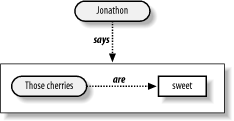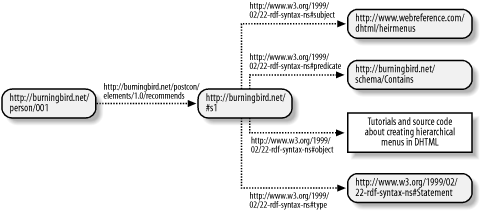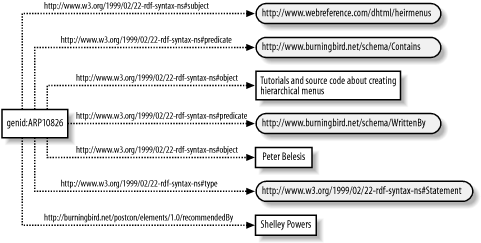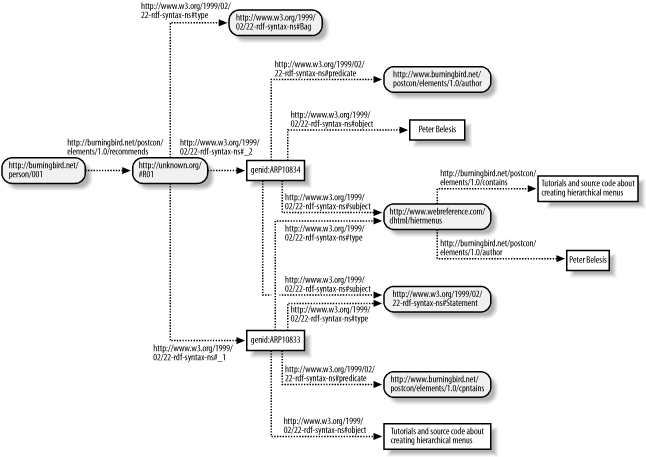| [ Team LiB ] |
|
4.3 Reification: The RDF Big UglyIn our legal system, a statement about a statement is considered hearsay and isn't admissible in a court of law. Within the Resource Description Framework (RDF), this is also true—the implied statement is considered hearsay and can't be accepted as an assertion by itself. However, the outer statement is treated as an assertion. In a sentence such as "Jonathon says those cherries are sweet," we're really reading two statements. The first, inner statement is "Those cherries are sweet." Since we haven't tried the cherries directly, we can't judge for ourselves whether this is true. But we do directly experience the outer statement, "Jonathon says...," and we can judge this to be an assertion of fact. Graphically, this would look like the picture shown in Figure 4-4. Figure 4-4. An example of a statement about a statement Now depending on our trust in Jonathon—that he tells the truth, that his interpretation of sweet is the same as ours—we can infer a trust for the inner statement, "those cherries are sweet," based on our trust of the outer statement. If I run into Jonathon at a market and he says "Those cherries are sweet," and I trust Jonathon and his judgment, I might be moved to purchase some of the cherries. This same process of validating an inner statement based on trust of the outer—validation of hearsay—formed the basis of much of the earlier communication about the RDF construct called reification. And it is the implied trust that has created much of the push back against it, when there is no true implied trust with reification. With reification, a statement is modeled as a resource referenced by another statement. No more, no less. Within the RDF semantics, a statement such as the following (from the specification), is easily documented with the RDF syntax provided in Chapter 3: Ora Lassila is the creator of the resource http://www.w3.org/Home/Lassila. In this statement, the RDF components of subject, predicate, and object are clearly understood: the subject (resource) is http://www.w3.org/Home/Lassila, predicate is creator, and object is Ora Lassila. However, attach this statement as a statement being asserted by another person: Ralph Swick says that Ora Lassila is the creator of the resource http://www.w3.org/Home/Lassila. The syntax used in the examples in Chapter 3 doesn't provide a mechanism to capture this type of assertion—this statement about another statement. However, capturing this type of information is exactly what's needed when trying to assert that a statement about another statement is the fact being defined. Statements such as "Ralph Swick says..." or "Jonathon says..." are termed metastatements; reification is a method of formally modeling a statement in such a way that it can actually be attached as a property to the new statement. We'll take a look at how reification is handled currently within the RDF specification. Later in the chapter, we'll look at some of the discussions about reification, as well as uses of the concept.
4.3.1 Reified StatementsOccasionally I receive emails asking me to recommend web pages that contain tutorials, technical articles, and other helpful information. Instead of answering individual emails, my preference is to post a web page with links to resources that might be of interest to folks. For instance, I'm frequently asked about creating drop-down menus in Dynamic HTML (DHTML), and I'll recommend the DHTML menu tutorials at WebReference.com, a very popular web site for the web developer: http://www.webreference.com/dhtml/hiermenus is a source containing tutorials and source code about creating hierarchical menus in DHTML. Mapping this recommendation into RDF/XML, I would have something similar to the following: <rdf:Description rdf:about="http://www.webreference.com/dhtml/hiermenus/">
<pstcn:Contains>Tutorials and source code about creating hierarchical
menus in DHTML</pstcn:Contains>
</rdf:Description>
Now, this description is sufficient if all I want to do is describe the resource (the web page) and the context (provides tutorials and source code on creating DHTML hierarchical menus). But it's missing one thing: an assertion about who is making the recommendation (me). Remove this RDF content from my web site, and you've lost the original context of the recommendation—the person making the recommendation. Within the RDF lexicon, we're missing the statement about the statement. To fill this gap, we need to associate the original statement to the new statement—the recommendation of the resource. To do this, we model the original statement so that it can be referenced as the subject of the newer statement. This forms the basis of reification in RDF. You can do this in a couple of different ways—using the long form or the short form of reification. The long form of reification formally defines types— rdf:subject, rdf:predicate, and rdf:object—and makes use of a fourth, rdf:type, with a predefined value of rdf:Statement. The three new predicates capture the information about the inner statement, the statement being reified if you will. rdf:type specifies that the resource is a statement.
At its simplest, the outer statement is attached as a statement directly to the reified statement. Example 4-7 contains an example of this type of reification. Example 4-7. Formal reification of a statement<?xml version="1.0"?>
<rdf:RDF
xmlns:rdf="http://www.w3.org/1999/02/22-rdf-syntax-ns#"
xmlns:pstcn="http://burningbird.net/postcon/elements/1.0/">
<rdf:Description rdf:about="http://burningbird.net/recommendation.htm">
<rdf:subject rdf:resource="http://www.webreference.com/dhtml/hiermenus" />
<rdf:predicate rdf:resource="http://burningbird.net/schema/Contains" />
<rdf:object>Tutorials and source code about creating hierarchical menus in DHTML</rdf:
object>
<rdf:type rdf:resource="http://www.w3.org/1999/02/22-rdf-syntax-ns#Statement" />
<pstcn:recommendedBy>Shelley Powers</pstcn:recommendedBy>
</rdf:Description>
</rdf:RDF>
In this document, graphically demonstrated in Figure 4-5, a statement is being made about a resource: the resource at http://www.webreference.com/dhtml/hiermenus contains tutorials and source code about creating hierarchical menus in DHTML. Who made the statement is given in the value of the pstcn:recommendedBy predicate: Shelley Powers. However, what we're saying is that this statement about the statement, the "Shelley Powers recommends..." itself, is the assertion; we can't determine the truthfulness of the actual recommendation until we visit the site or we take my statement as truth based on the trust placed in me. Figure 4-5. Graph showing simple example of RDF reification Though this is valid RDF, it isn't my preferred way of demonstrating a clear-cut separation between the reified statement and the assertion attached to that statement (demonstrating the inner and outer statements). My preferred approach for reification is to formally define a separate RDF resource for the outer statement and then attach it to the reified statement. Example 4-8 demonstrates this. The use of rdf:resource in the outer statement connects the two statements. Example 4-8. Providing a statement about a statement within RDF<?xml version="1.0"?>
<rdf:RDF
xmlns:rdf="http://www.w3.org/1999/02/22-rdf-syntax-ns#"
xmlns:pstcn="http://burningbird.net/postcon/elements/1.0/"
xml:base="http://burningbird.net/">
<rdf:Description rdf:about="#s1">
<rdf:subject rdf:resource="http://www.webreference.com/dhtml/hiermenus" />
<rdf:predicate rdf:resource="http://burningbird.net/schema/Contains" />
<rdf:object>Tutorials and source code about creating hierarchical menus
in DHTML</rdf:object>
<rdf:type rdf:resource="http://www.w3.org/1999/02/22-rdf-syntax-ns#Statement" />
</rdf:Description>
<rdf:Description rdf:about="http://burningbird.net/person/001">
<pstcn:recommends rdf:resource="#s1" />
</rdf:Description>
</rdf:RDF>
In the example, the assertion about the reified statement is formally separated out. The RDF Validator-generated graphic of the RDF is shown in Figure 4-6. Figure 4-6. RDF Validator-generated graph of reification example In my opinion, this RDF results in a clearer and cleaner interpretation of the "statement about a statement."
Having to repeat the subject, predicate, and object statements in every instance of reification is cumbersome, so there's a short form you can use to achieve exactly the same RDF graph. And if the graphs agree, the RDF statements are guaranteed to agree. The subject, predicate, and object of the reified statement are the familiar RDF trio, but the context of their use differs with reification. With reified statements, the subject, predicate, and object attributes are formal RDF elements that, combined, also happen to be a statement. These new components are used to model the statement. A more detailed description of these new RDF elements is:
The formal representation of reification is based on N-Triples syntax. The reification from Examples Example 4-1 and Example 4-2 could be represented as: {[X], type, [RDF:Statement]}
{[X], predicate, [contains]}
{[X], subject, [http://www.webreference.com/dhtml/hiermenus]}
{[X], object, "Tutorial..."}
This representation strips the statement to its essential components sans XML syntax. It's interesting that within the RDF Syntax Specification, the quad or 4-tuple representing a reified statement (subject, predicate, object, and type) is really a formalized model of our old friend, the RDF Description. Consider for a moment that an RDF Description with at least one property is an RDF statement, containing subject, object, and predicate. This is represented by: <rdf:Description rdf:about="http://www.webreference.com/dhtml/hiermenus/">
<pstcn:Contains>Tuturials and source code about creating hierarchichal
menus in DHTML</pstcn:Contains>
</rdf:Description>
However, let's look at identifying this in "straight" XML as follows, using a custom XML vocabulary called myrdf: <myrdf:element>
<myrdf:subject>http://www.webreference.com/dhtml/hiermenus/"</myrdf:subject>
<myrdf:predicate>Contains</myrdf:predicate>
<myrdf:object>Tutorials and source code about
creating hierarchical menus in DHTML</myrdf:object>
</myrdf:element>
As you can see, this formal modeling of RDF Description is equivalent to the syntax used to model the reified statement given earlier. Following from this, then, you could say that all asserted statements within RDF (all statements given within RDF Description elements) are reified statements, and you would be correct—sort of. The key to understanding reification within RDF is that a reified statement isn't the statement itself, but the model of the statement. Reification isn't the process of making a statement about another statement; it's the process of formally modeling the statement. From this example, you might be wondering why reification is necessary. After all, for this particular example, the recommendation could be attached directly as another statement about the web resource. 4.3.2 The Necessity of Reification and MetastatementsWhy is reification necessary? One could model the example shown in Example 4-1 in serialized RDF syntax and not lose the information about who recommends the resource, as shown in Example 4-9. Example 4-9. Using RDF/XML to model a recommendation<?xml version="1.0"?>
<rdf:RDF
xmlns:rdf="http://www.w3.org/1999/02/22-rdf-syntax-ns#"
xmlns:pstcn="http://burningbird.net/postcon/elements/1.0/"
<rdf:Description rdf:about="http://www.webreference.com/dhtml/hiermenus/">
<pstcn:Contains>Tuturials and source code about creating hierarchichal
menus in DHTML</pstcn:Contains>
<pstcn:recommendedBy>Shelley Powers</pstcn:recommendedBy>
</rdf:Description>
</rdf:RDF>
In this document, information about the person making the recommendation is attached as an additional statement about the original subject. At first glance, the new version of the RDF syntax used to describe the recommendation seems acceptable. However, using this interpretation, key information is lost—the statement about the resource is being treated as the fact, not the recommendation itself. With something such as the following: Shelley Powers recommends http://www.webreference.com/dhtml/hiermenus as a source of tutorials and source code for hierarchical menus created in DHTML. the fact being described in the RDF document is "Shelley Powers recommends...," not the actual web resource. The web resource is actually an ancillary component of the recommendation. By being able to model the statement about the web resource, you can treat it as a property of another statement, and be able to distinguish without confusion and without ambiguity what "fact" you're describing in an RDF statement. The importance of the distinction between the thing described (the web site) and the object making the description (the person making a recommendation of the web site) is both the key and the confusion of reification. As handy as reification is, it is a bit wordy. The next section discusses a shorthand technique that can be used to reify several statements at a time. 4.3.3 A Shorthand Reification SyntaxSpecifying the full predicate, subject, object, and type for each reified statement isn't difficult, but it does get cumbersome after a while. Fortunately, there is a shorthand technique that you can use in place of the more formal syntax. In Example 4-10, rather than specifying each subject, predicate, object, and type, the reified statement is identified through the rdf:ID property, and the RDF parser automatically annotates the subject, predicate, object, and type. Example 4-10. Shorthand technique for RDF reification<?xml version="1.0"?>
<rdf:RDF
xmlns:rdf="http://www.w3.org/1999/02/22-rdf-syntax-ns#"
xmlns:pstcn="http://burningbird.net/postcon/elements/1.0/">
<!--The statement-->
<rdf:Description rdf:about="http://www.webreference.com/dhtml/hiermenus">
<pstcn:Contains rdf:ID='s1'>
Tutorials and source code about creating hierarchical menus in DHTML</pstcn:Contains>
</rdf:Description>
<!--The statement about the statement-->
<rdf:Description rdf:about="http://burningbird.net/person/001">
<pstcn:recommendedBy rdf:resource="#s1" />
</rdf:Description>
</rdf:RDF>
This shorthand technique is particularly helpful in circumstances other than just wanting a cleaner syntax. When you describe something, you usually don't make just one statement about the thing you're describing. For instance, if you're recommending an article, you'll usually give a description of the article, the name of the article, how to find a copy of the article, and so on. In the recommendation example earlier, this original statement could be extended to provide the author of the web resource as well as the content: Shelley Powers recommends http://www.webreference.com/dhtml/hiermenus, written by Peter Belesis, as a source of tutorials and source code for hierarchical menus created in DHTML. In this sentence, I'm recommending a web site that contains defined material and is authored by a specific individual. The formal syntactic method of modeling this statement using the 4-tuple reification syntax doesn't fit this particular data instance very well, because there's confusion about exactly what I'm recommending—the web site or the author? There is no clean way to add in the additional statements. To demonstrate my point, I modified the RDF/XML from Example 4-7 to add the additional statement related to the author. In this example, shown in Example 4-11, I interpreted the statement to break down into a couple of different assertions:
I then modified the RDF/XML to reify both statements from the same subject. Example 4-11. An attempt at diagramming a statement about multiple statements with the same subject<?xml version="1.0"?>
<rdf:RDF
xmlns:rdf="http://www.w3.org/1999/02/22-rdf-syntax-ns#"
xmlns:pstcn="http://burningbird.net/postcon/elements/1.0/">
<rdf:Description>
<rdf:subject rdf:resource="http://www.webreference.com/dhtml/hiermenus" />
<rdf:predicate rdf:resource="http://burningbird.net/schema/Contains" />
<rdf:object>Tutorials and source code about creating hierarchical menus
in DHTML</rdf:object>
<rdf:predicate rdf:resource="http://burningbird.net/schema/WrittenBy" />
<rdf:object>Peter Belesis</rdf:object>
<rdf:type rdf:resource="http://www.w3.org/1999/02/22-rdf-syntax-ns#Statement" />
<pstcn:recommendedBy>Shelley Powers</pstcn:recommendedBy>
</rdf:Description>
</rdf:RDF>
This RDF/XML in this document validates with the RDF Validator (at least, when this book was written), and the resultant graph shown in Figure 4-7 does represent what we want to say, in a way. However, our reaction to both the RDF/XML and the graph is "ugh." I was surprised this would validate because there is an assumption, though not specifically mentioned in the RDF Syntax Specification, that a predicate, object, and type for a reified statement are attached to one subject, and one subject has only one predicate and object. Figure 4-7. Graph of two reified statements sharing one subject—ugh Happily, there's a better approach to modeling this type of statement. In RDF, statements about a specific subject can be included within the same description through the use of multiple predicates and objects associated with the subject. With the web resource example, the site contents and author are both facts about the resource and can be modeled as: <rdf:Description rdf:about="http://www.webreference.com/dhtml/hiermenus/">
<pstn:Contains>Tuturials and source code about creating hierarchichal
menus in DHTML</pstn:Contains>
<pstcn:writtenBy>Peter Belesis</pstcn:writtenBy>
</rdf:Description>
Several statements can be included within one RDF Description because there's an implicit grouping associated with this element, an rdf:Bag that acts as a container for all statements about a specific resource. The concept of an implicit description container also works with reified statements through the introduction of a new RDF attribute, rdf:bagID. The rdf:bagID attribute is used to identify the implicit Bag defined with the RDF Description element that groups multiple statements about a specific subject.
With the example about the web content, the rdf:bagId is used to wrap both statements about the web site being recommended: <rdf:Description rdf:about="http://www.webreference.com/dhtml/hiermenus"
rdf:bagID="R01">
<pstcn:Contains> Tutorials and source code about creating hierarchical menus
in DHTML</pstcn:Contains>
<pstcn:Author>Peter Belesis</pstcn:Author>
</rdf:Description>
In this XML example, both statements being made—what the content of the resource is and who authored it—are contained within an RDF Description identified by the given rdf:bagID. With this approach, there is no confusion that we have two statements being made about one resource and that the higher-order recommendation is being made against the resource, rather than any one individual statement about the resource. To complete the RDF document, all that's left is to attach the higher-order statement. A complete XML document containing the new RDF is shown in Example 4-12. Example 4-12. Syntactic shorthand demonstrating higher-order and reified RDF statements<?xml version="1.0"?>
<rdf:RDF
xmlns:rdf="http://www.w3.org/1999/02/22-rdf-syntax-ns#"
xmlns:pstcn="http://burningbird.net/postcon/elements/1.0/">
<rdf:Description rdf:about="http://www.webreference.com/dhtml/hiermenus"
rdf:bagID="R01">
<pstcn:contains> Tutorials and source code about creating hierarchical menus
in DHTML</pstcn:contains>
<pstcn:author>Peter Belesis</pstcn:author>
</rdf:Description>
<rdf:Description rdf:about="http://burningbird.net/person/001">
<pstcn:recommendeds rdf:resource="#R01" />
</rdf:Description>
</rdf:RDF>
The complete example, converted to a directed graph, is shown in Figure 4-8. Figure 4-8. Reification when more than one inner statement is being made 4.3.4 What Reification SolvesAs we've seen in the examples earlier in the chapter, RDF reification is the only technique within RDF to model statements so that they can be grouped or attached as properties to another statement. In the examples, reified statements were used to capture information about a statement (a recommendation) made about another statement (a web resource). In real-world situations, how would reification be used? What would it solve? Well, the key component of reification is the ability to make a statement and have the statement be treated as fact, without any implication that the contents of the statement are themselves facts. This has particular interest when it comes to trust. 4.3.4.1 Implying trustIn the earlier examples, we looked at modeling a recommendation for a web site using RDF and reification. The recommendation didn't specifically address any level of trust—just the nature of the contents of the site and who wrote it. However, reification can be used to establish a level of trust. As an example, 10 years ago if someone asked where you shopped for books, you might recommend a local neighborhood bookstore and say something along the lines of "they have a good selection," or "Joe will let you browse all day without hassling you," or even "the store cat's a real sweetie." You would then follow this person's recommendation based on your own belief in that person's judgment and honesty. (During direct verification of the facts represented in the recommendation, if your hand gets shredded by the "sweet cat" when you try to pet it, you might modify your level of trust in the person's judgment when it comes to animals.) Nowadays when the "neighborhood" is several million kilometers of wire, providing recommendations to your neighbors is a bit more complicated. You can create web pages with reviews and attach links to stores, but this won't provide useful information to automated agents that are out to do more than randomly collect links to stores. No, instead of just specifying a link to a store, you want to attach your views, your opinions, to the store. Let's say you shop at a bookstore called Some Bookstore. You like and trust this store so you provide a link to it at your web site. In addition, you also provide an RDF Description of the store, given in Example 4-13, for any RDF consumable agents that are looking for stores that can be trusted. Example 4-13. RDF Description of a bookstore<?xml version="1.0"?>
<rdf:RDF
xmlns:rdf="http://www.w3.org/1999/02/22-rdf-syntax-ns#"
xmlns:pstcn="http://burningbird.net/postcon/elements/1.0/">
<rdf:Description rdf:about="http://www.somebookstore.com/">
<pstcn:webPurpose>online store</pstcn:webPurpose>
<pstcn:name>Some Bookstore</pstcn:name>
<pstcn:storeType>bookstore</pstcn:storeType>
<pstcn:trustLevel>High</pstcn:trustLevel>
</rdf:Description>
</rdf:RDF>
An agent would be able to not only collect the link for the store, it would also collect information about the store (the link belongs to an online bookstore that can be trusted—i.e., the trust level is high). The agent would store the information about the link in its online storage, which is then used by a person searching for an online bookstore that can be trusted. The results of the search would display the following: Some Bookstore, found at http://www.somebookstore.com/, is an online bookstore. Trust in this store is high. This is great, just what the person wanted—or is it? Some of the information collected by the agent and supplied in the Example 4-8 RDF/XML can be easily verified just by going out to the store web site. However, the issue of trust implied in the search results can't be verified because the context of that trust—the originator of the statement about trust—is gone. The RDF supplied in Example 4-13 is modified to use a higher-order statement supplying information about the originator of the trust specification. The modified RDF is shown in Example 4-14. Example 4-14. Using reification to attach the originator of trust<?xml version="1.0"?> <rdf:RDF xmlns:rdf="http://www.w3.org/1999/02/22-rdf-syntax-ns#" xmlns:pstcn="http://burningbird.net/postcon/elements/1.0/"> <rdf:Description rdf:about="http://www.somebookstore.com" rdf:bagID="s1"> <pstcn:name>Some Bookstore</pstcn:name> <pstcn:storeType>bookstore</pstcn:storeType> <pstcn:trustLevel>High</pstcn:trustLevel> </rdf:Description> <!--The statement about the statement--> <rdf:Description rdf:about="http://burningbird.net/schema/ShelleyPowers"> <pstcn:recommendedBy rdf:resource="#s1" /> </rdf:Description> </rdf:RDF> With this modification, the search engine results would be: Some Bookstore, found at http://www.somebookstore.com/, is an online bookstore. Trust in this store is high. The assertion about the type of store and the trust in the store is provided by Shelley Powers. Now the person shopping for an online bookstore has the information necessary to verify the source of the level of trust. Of course, the person would then have to determine if the source of the information is someone who can also be trusted. (Trust me. I can be trusted.) 4.3.4.2 Metadata about statementsAnother use of reification is to record metadata information about a specific statement. For instance, if the statement about the resource (not the resource itself) is valid only after a specific date or only within a specific area or use, this type of information can be recorded using reification. Reification should be used because statement properties would associate the information directly to the resource, rather than to the statement. One of the problems with the web today is that so many links to sites are obsolete, primarily because the original resource has been removed or moved to a new location. Web pages can have an expiration date attached to them, but that's not going to help when adding a link to the web resource among your own pages. It's the link or reference that needs to age gracefully, not the original resource. To solve this, valid date information can be attached to the reference to the web resource, rather than being attached directly to the resource itself. In Example 4-15, very simple RDF is used to describe a resource, an article, containing vacation and travel spot information. Attached to this recommendation is a constraint that the reference to this article is valid only for the year 2002. Example 4-15. Providing a valid date for an article<?xml version="1.0"?>
<rdf:RDF
xmlns:rdf="http://www.w3.org/1999/02/22-rdf-syntax-ns#"
xmlns:pstcn="http://burningbird.net/postcon/elements/1.0/">
<rdf:Description>
<rdf:subject rdf:resource="http://burningbird.net/somearticle.htm" />
<rdf:predicate rdf:resource=
"http://burningbird.net/schema/Recommendations" />
<rdf:object>Vacation and Travel Spots</rdf:object>
<rdf:type rdf:resource="http://www.w3.org/1999/02/22-rdf-syntax-ns#Statement" />
<pstcn:validFor>2002</pstcn:validFor>
</rdf:Description>
</rdf:RDF>
By using reification, we've attached a valid date range to the reference to the article rather than directly to the article. We're saying that this reference (link) is valid only in the year 2002, rather than implying that the article the link is referencing is valid only in the year 2002. |
| [ Team LiB ] |
|